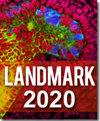与 TMB 信号相关的 RCAN2 通过上调肝细胞癌中的 EHF/DR5 通路促进细胞凋亡
IF 3.1
4区 生物学
Q2 Immunology and Microbiology
引用次数: 0
摘要
背景:肿瘤突变负荷(TMB)是体细胞突变积累的重要指标,被认为与肿瘤的生物学行为和预后有关。然而,这些关联的相关遗传机制仍不清楚。本研究旨在确定肝细胞癌(HCC)中与TMB相关的关键基因,并研究其生物学功能、下游转录因子和作用机制。方法:根据TMB特征相关基因对癌症基因组图谱-肝细胞癌(TCGA-LIHC)数据库中的患者进行分类。确定了与TMB特征和肿瘤预后相关的关键基因。然后使用免疫组化和定量实时聚合酶链反应(qPCR)评估临床 HCC 组织和 HCC 细胞中的基因表达。对基因表达发生改变的细胞进行了体外和体内细胞增殖和凋亡影响评估。利用三个独立的数据库和细胞测序数据确定了相关机制和下游转录因子。还通过改变体外下游转录因子的表达来研究其机制。结果:以 99 个 TMB 特征相关基因为特征的整合群(IC)2 组与 IC1 组相比,TMB 评分有显著差异(p < 0.001),肿瘤预后也更有利(p = 0.031)。我们确定了五个关键预后基因,这些基因在 IC2 和 IC1 之间有差异表达,并与总生存期相关。在所研究的 33 种肿瘤类型中,有 18 种肿瘤类型的关键预后基因之一 RCAN2 的表达与 TMB 呈负相关。高水平的 RCAN2 与较好的 HCC 总生存率相关(p = 0.0009)。过表达 RCAN2 会增强体外和体内的细胞凋亡,而敲除 RCAN2 则会减弱细胞凋亡。RCAN2促进细胞凋亡的机制可能包括上调ETS同源因子(EHF)和死亡受体5(DR5)的表达。结论 :在多种癌症类型中,RCAN2表达下调与TMB升高相关。研究还发现,RCAN2 是预测 HCC 预后的生物标志物,并能通过 EHF/DR5 通路促进 HCC 细胞凋亡。这些发现为TMB较高的晚期HCC的系统治疗提供了新的视角。本文章由计算机程序翻译,如有差异,请以英文原文为准。
TMB Signature-Related RCAN2 Promotes Apoptosis by Upregulating EHF/DR5 Pathway in Hepatocellular Carcinoma
Background : The tumour mutation burden (TMB) is a valuable indicator of the accumulation of somatic mutations, and is thought to be associated with the biological behaviour and prognosis of tumours. However, the related genetic mechanism for these association is still unclear. The aim of the present study was to identify the key gene(s) associated with TMB in hepatocellular carcinoma (HCC) and to investigate its biological functions, downstream transcription factors, and mechanism of action. Methods : Patients in The Cancer Genome Atlas-Liver Hepatocellular Carcinoma (TCGA-LIHC) database were classified according to TMB signature-related genes. Key genes related to the TMB signature and tumour prognosis were identified. Immunohistochemistry and Quantitative Real-Time Polymerase Chain Reaction (qPCR) were then used to assess gene expression in clinical HCC tissues and HCC cells. Cells with altered gene expression were evaluated for the effect on cell proliferation and apoptosis, both in vitro and in vivo . Three independent databases and cell sequencing data were used to identify the mechanisms involved and the downstream transcription factors. The mechanism was also studied by altering the expression of downstream transcription factors in vitro . Result : The integrated cluster (IC) 2 group, characterized by 99 TMB signature-related genes, showed a significant different TMB score compared to the IC1 group ( p < 0.001), as well as more favourable tumour prognosis ( p = 0.031). We identified five key prognostic genes that were differentially expressed between IC2 and IC1 and were associated with overall survival. The expression of one of these key prognostic genes, RCAN2 , was negatively correlated with TMB in 18 out of 33 tumour types examined. A high level of RCAN2 was correlated with better overall survival in HCC ( p = 0.0009). Overexpression of RCAN2 enhanced apoptosis in vitro and in vivo , whereas knockdown of RCAN2 attenuated apoptosis. The mechanism by which RCAN2 promotes apoptosis may involve upregulation of the expression of ETS homologous factor ( EHF ) and of death receptor 5 ( DR5 ). Conclusions : Downregulation of RCAN2 expression was found to correlate with elevated TMB in multiple cancer types. RCAN2 was also found to be a biomarker of HCC prognosis, and to promote the apoptosis of HCC cells through the EHF/DR5 pathway. These findings provide a new perspective on systemic treatment for advanced HCC with a high TMB.
求助全文
通过发布文献求助,成功后即可免费获取论文全文。
去求助
来源期刊

Frontiers in Bioscience-Landmark
生物-生化与分子生物学
CiteScore
3.40
自引率
3.20%
发文量
301
审稿时长
3 months
期刊介绍:
FBL is an international peer-reviewed open access journal of biological and medical science. FBL publishes state of the art advances in any discipline in the area of biology and medicine, including biochemistry and molecular biology, parasitology, virology, immunology, epidemiology, microbiology, entomology, botany, agronomy, as well as basic medicine, preventive medicine, bioinformatics and other related topics.
 求助内容:
求助内容: 应助结果提醒方式:
应助结果提醒方式:


